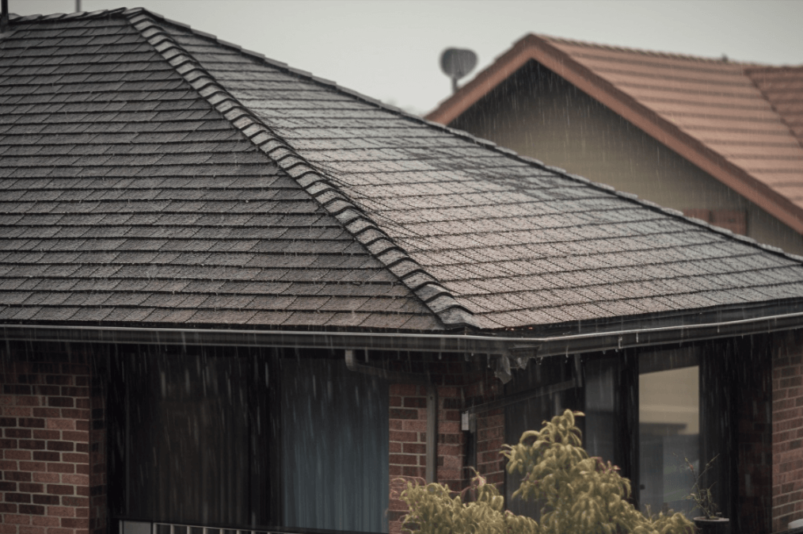
What is Impact Resistance in Roofing?
When we talk about impact resistance in roofing, we’re referring to how well your roof can handle getting hit by things like hail, tree branches, or other debris that might come flying during a storm. Think of it as your roof’s armor, ready to absorb the shock and keep everything underneath safe. Impact-resistant materials are specifically designed to stand up to these hits, reducing the chances of leaks or other damage that can turn into costly repairs down the line.
To make sure roofing materials are tough enough, they go through a rigorous test called the UL 2218 Impact Rating Test. Here’s how it works: a steel ball (think of it like a really heavy hailstone) is dropped from different heights onto the material. After the impact, they check for any cracks, dents, or other signs of damage. Based on how well the material holds up, it gets a rating from Class 1 to Class 4, with Class 4 being the best. This test is like a badge of honor for roofing materials, showing they can take a hit when it matters most.
Types of Impact-Resistant Roofing Materials
Roofing materials are put into different classes based on how well they perform in that steel ball test. If you’re looking for the best protection, you’ll want to aim for Class 4 materials—they’re the heavyweights in the roofing world. On the other hand, Class 1 materials are more like the lightweight contenders. If you live somewhere with wild weather, like frequent hailstorms, investing in a Class 4 roof can give you that extra peace of mind knowing your home is better protected.
Comparing Roofing Materials: Asphalt, Architectural, and More
Not all roofing materials are created equal, especially when it comes to standing up to a good whack from Mother Nature. Basic asphalt shingles are popular because they’re affordable and easy to install, but unless they’re specifically made for impact resistance, they might not be the best choice in a storm. Architectural shingles, which are thicker and more durable, offer better protection. Then you’ve got materials like metal, slate, and tile, which can vary in how much impact they can handle. The key is finding that sweet spot between the look you want and the protection you need.
The Science Behind Impact-Resistant Shingles: What Makes Them Tough?
So, what makes impact-resistant shingles tougher than your average roof? It’s all about the materials and design. These shingles often have a reinforced fiberglass mat or modified asphalt, giving them the strength to absorb and spread out the energy from an impact. Some even have a special polymer coating that adds another layer of defense. All this engineering means these shingles can take a beating and keep your roof looking good as new, even after a rough storm.
The Cost of Impact-Resistant Roofing Options
Sure, impact-resistant roofing might cost a bit more upfront, but it’s an investment that can pay off in the long run. You’re not just buying a roof—you’re buying peace of mind. Plus, you might save on insurance premiums and avoid costly repairs down the road. While asphalt shingles designed for impact resistance are usually more budget-friendly than metal or slate, they still come with a bit of a premium over standard options. But when you consider the protection they offer, it’s often worth the extra cost.
Advantages of Impact-Resistant Roofs
So, why should you go for an impact-resistant roof? Well, think of it as a suit of armor for your home. Whether it’s hailstones the size of golf balls or a wayward branch during a windstorm, an impact-resistant roof is designed to take the hit and keep your home safe. It’s not just about avoiding leaks or damage to your roof, either—it’s about protecting everything underneath it.
With a stronger roof, you’re less likely to face the headaches of interior water damage or costly repairs after a big storm. And let’s be honest, knowing your roof can handle whatever nature throws at it? That’s priceless.
When it comes to hailstorms and extreme weather, not all roofs are up to the challenge. Impact-resistant roofs, however, are built to shrug off those big hits. Imagine a storm rolls through, and while your neighbors are dealing with cracked shingles and leaks, your roof just keeps on going. The secret lies in how these materials are designed—they’re tough enough to handle the impact without cracking or breaking. So, whether it’s hail, heavy winds, or even debris blown around in a storm, an impact-resistant roof is your home’s first line of defense.
Impact Resistance vs. Durability: Why the Difference Matters
Impact resistance and durability might sound like the same thing, but they’re actually a bit different—kind of like comparing a sprinter to a marathon runner. Impact resistance is all about how well your roof can handle sudden, forceful impacts, like hail or falling branches (sprinting). It’s that quick, one-time hit where you need your roof to stand strong. Durability, on the other hand, is about the long game (marathon). It’s how well your roof holds up over years of sun, rain, snow, and everything in between.
Why does this matter? Well, you want a roof that can do both. A roof might be durable, lasting for decades under normal conditions, but if it can’t take a hit from a hailstorm, you’re still in trouble. On the flip side, a roof that’s impact-resistant but not durable might survive a storm but wear out faster over time. The best roofing materials combine both qualities, giving you peace of mind in both the short and long term.
Maintaining Your Impact-Resistant Roof
Even though an impact-resistant roof is built to last, it still needs regular care to stay in peak condition. Here are a few key maintenance tips:
- Keep Gutters Clean: Clogged gutters can lead to water backup, which can damage your roof over time. Make it a habit to clean them out regularly, especially after a storm.
- Inspect After Storms: Always check your roof after a big storm. Look for any loose or damaged shingles. If you notice anything out of place, address it immediately to prevent more significant issues.
- Trim Overhanging Branches: Trees near your home can pose a threat to your roof, especially during storms. Regularly trim back branches that hang over your roof to prevent them from falling and causing damage.
- Schedule Professional Inspections: Have a professional roof inspection at least once a year, or after any major weather event, to catch potential problems early.
- Monitor Vulnerable Areas: Pay special attention to areas where debris tends to collect, such as roof valleys or around chimneys. These spots are more susceptible to water damage if not properly maintained.
With these best practices, you can maximize the lifespan of your impact-resistant roof and keep it performing at its best.
Are Impact-Resistant Roofs Worth the Investment?
At first glance, impact-resistant roofs might seem like a bigger investment than standard options. But when you break it down, the benefits often outweigh the costs. Sure, you’ll pay more upfront, but consider the potential savings: fewer repairs after storms, lower insurance premiums, and the peace of mind that comes with knowing your home is well-protected. Plus, if you plan to stay in your home for a long time, that extra investment can pay off in the form of a longer-lasting roof that doesn’t need replacing as often.
Whether you prefer the classic look of asphalt shingles, the bold statement of metal roofing, or the elegance of slate, there’s an impact-resistant option that fits your style. Many manufacturers offer impact-resistant versions of their most popular roofing materials, so you don’t have to sacrifice aesthetics for protection. It’s all about finding the right balance between the look you love and the durability you need. And with the variety of styles available, you can protect your home without compromising on curb appeal.
Protect Your Home with an Impact-Resistant Roof
An impact-resistant roof is more than just a feature—it’s a commitment to protecting your home from the unpredictable forces of nature. Whether you’re upgrading your current roof or building a new home, impact-resistant materials offer peace of mind, knowing that your roof is ready to take on whatever comes its way. So, when it’s time to make a decision, remember: a strong roof is the first line of defense for everything you hold dear.





